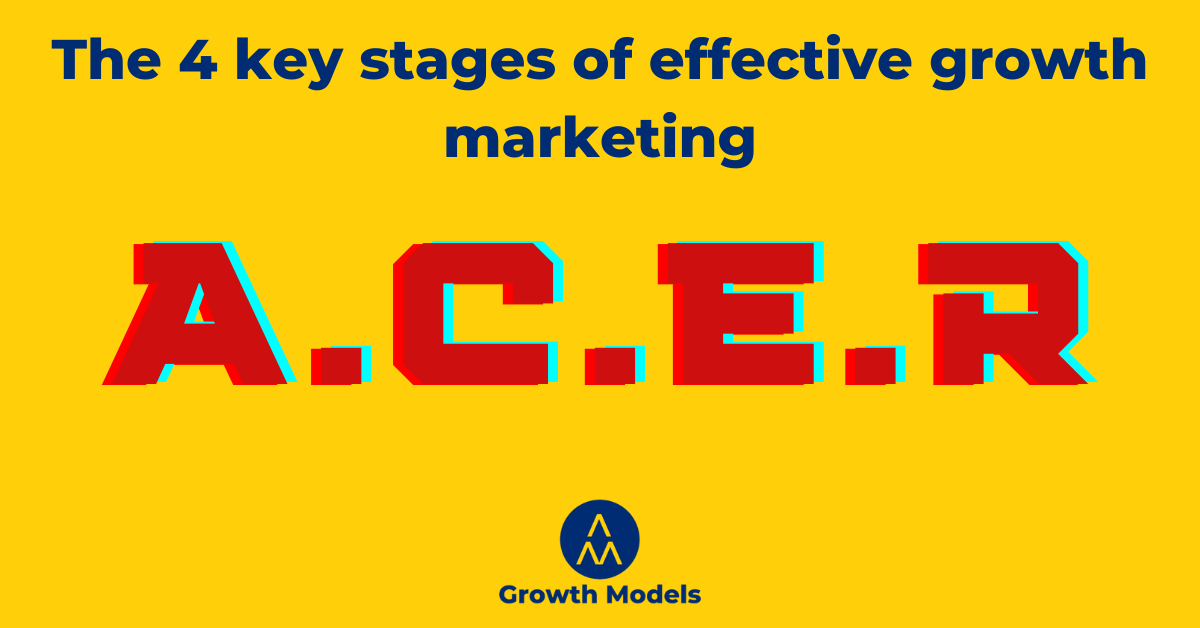What is actually needed to implement a successful growth marketing strategy?
Over the years I’ve analysed hundreds of growth models and dug deep into the growth engines of both large and small brands.
This is one of the questions I find is often overcomplicated when it should be simple.
Simple, but not easy.
Let’s dive into what makes an effective growth strategy for your brand.
The common advice on growth marketing
A lot of the advice around growth marketing is, in my opinion, overly complex.
You’ll see images like the below and detailed, multi-thousand-word explanations on each stage and how to get the most out of it.
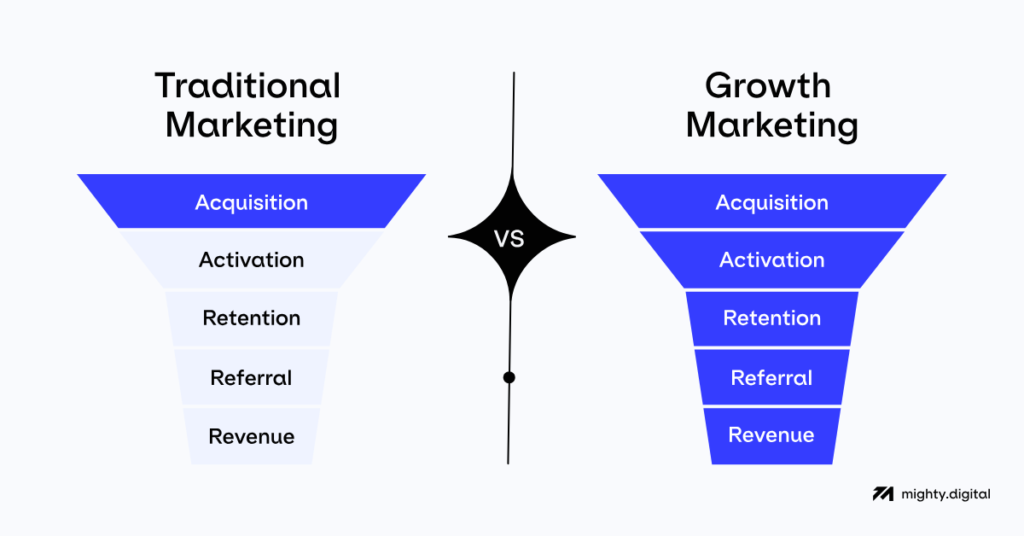
It;s not wrong, I just don’t think it helps a lot of us.
I often find that these kinds of articles are written to rank well in search, and they’re created by either…
- Freelancers who are writers and not growth marketers
- VCs who need to justify their overly complex thoughts on growth
Personally, I don’t buy it.
These super complex approaches might be the best fit for huge brands with hundreds of millions in funding, but I know from first-hand experience you can get great results by focusing on 4 key areas.
If you can get good, but not necessarily great, results at each 4 stages you can grow an effective brand. Here’s how I view growth marketing and build growth marketing systems that have generated millions in revenue.
The ACER approach to growth marketing
At its core, a good growth model should have a single, solid, converting asset at each of the below stages…
- Attract – helping customers to find you
- Convert – Turning visitors to leads/free users, and then to customers
- Engage – Help them engage with the offer to get the most value from it
- Refer – Build a system where they can refer their friends and other customers
I actually recorded a video explaining my approach to this below.
You don’t need a super complex approach to any of these either.
Simple, effective assets at each stage will help you scale your brand.
In fact, in the last few months I’ve consulted several brands – all doing low to mid 7-figures in revenue.
Often, these are small teams of between 1 and 5 people.
They all had very simple growth models.
One ran ads to a video sales letter, and then an email sequence. they were doing $2.4M / year.
Another was clearing around $3M/year through SEO and landing pages.
Finally, I talked to a $7M/year business that used community collaborations and email nurture.
When you’re a small brand you don’t need to overcomplicate things and multi-channel approaches.
You’re splitting your attention and will dilute your results.
But this is what people do. because, at each stage there are dozens of potential approaches you could take.
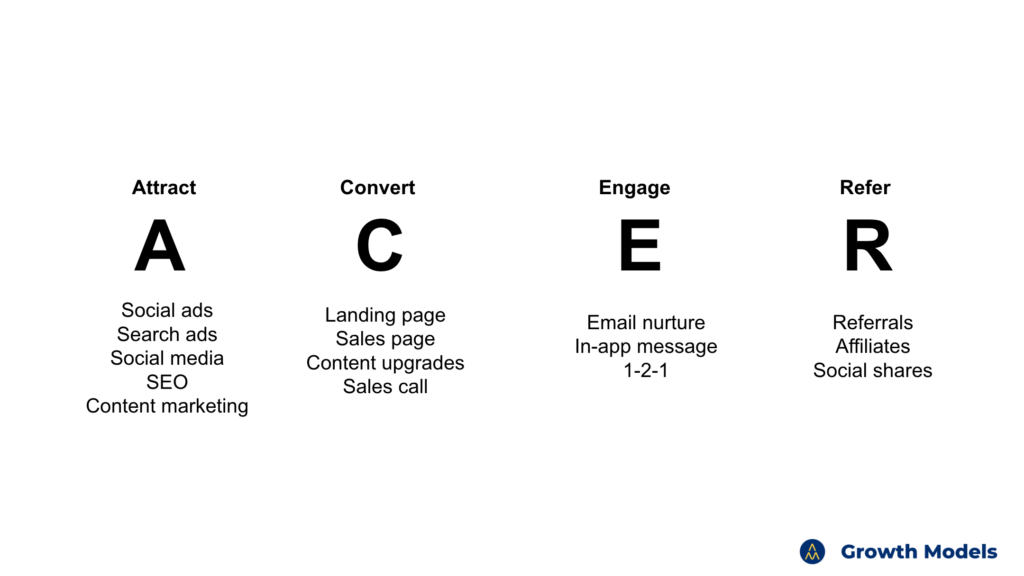
If you don’t have a huge team to grow your business, don’t try and chase every action at each stage. It’s a waste of time. You split your attention and dilute your results.
You’re better off choosing the approach at each stage you can do best at, and then doubling down on it.

There is no one right way to grow your brand. But there’s a model out there that’s built for your brand. ‘ll help your brand get the best results.
I’ll explain a little more detail on each step below.
If you want to jump this, take the growth model quiz to find out what would work best for you.
Take the growth model quiz nowNow, let’s get into the stages.
1. Attract
This is all about getting your offer in front of the right people.
And there are hundreds of ways to go about it.
Generally, they can be bundled into direct and indirect approaches.
Below are a handful of methods that fall into the two categories.
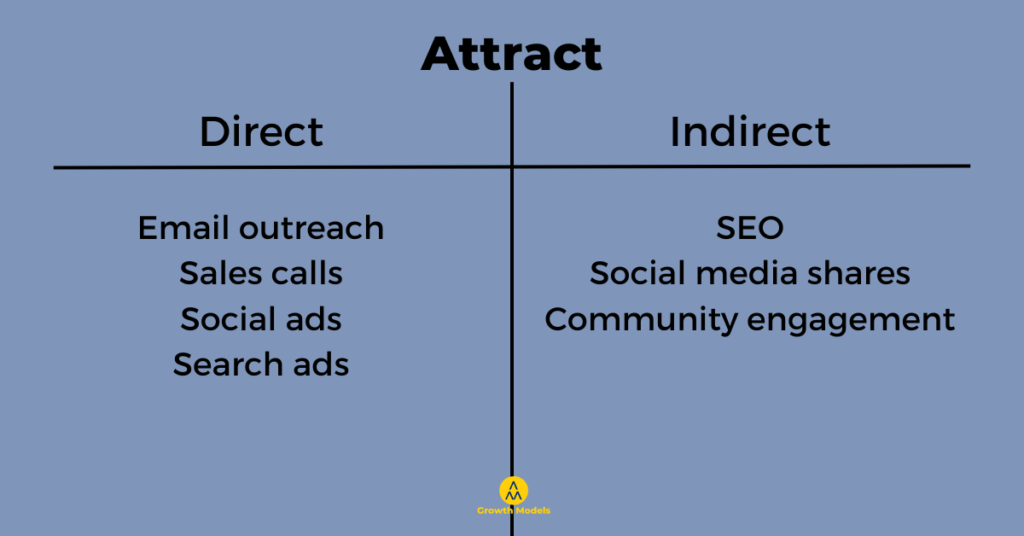
How. doyou decide whether to go direct or indirect?
It really comes down to payback period.
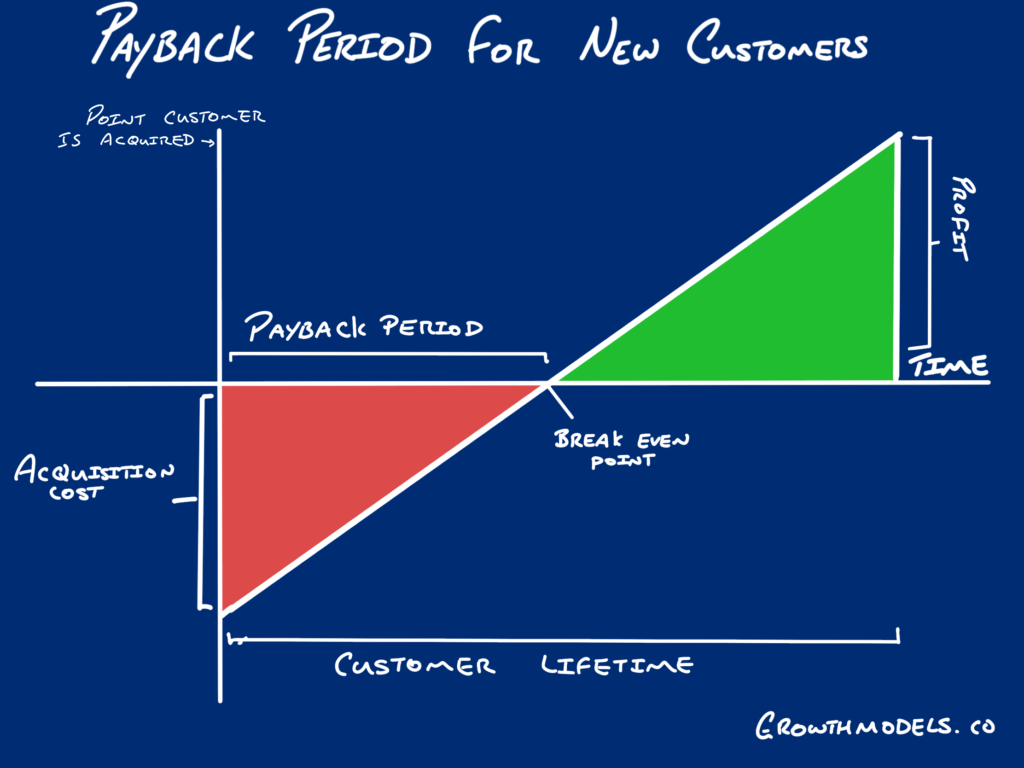
You have to make sure you at least break even before you hit serious financial trouble.
If you’re spending a lot of cash on acquiring customers but won’t break even for 3 months on each acquisition, you have to make sure you have enough cash reserves to last those 3 months.
Else you go bankrupt in that time.
With indirect methods you’re often waiting for an external algorithm or engine to find, rank, and promote your content to those who might benefit from it.
We’re talking Google for ranking through SEO, or the social media algos learning to like and boost your reach.
These are usually long-term plays for people who don’t need a short payback period.
They often also scale very well if you can ride out the tough first few months.
You can, of course, boost the success with a little bit of money behind the play.
Direct gets faster results, but often requires a more hands-on and/or expensive approach.
You’re going to need to pay for reach through ads, or spend considerable time doing direct outreach to ideal customers.
Both direct and indirect are valid, both free and paid are valid.
It really just depends on what method will work best for your brand, budget, and needs.
2. Convert
This is all about getting people who have taken note of your offer to either sign up to learn more, or try the trail version of your offer.
In cases like e-commerce, the conversion would be to get the sale.
As you can see, these are pretty different goals. So, anyone telling you “X is the only way to grow” is obviously wrong.
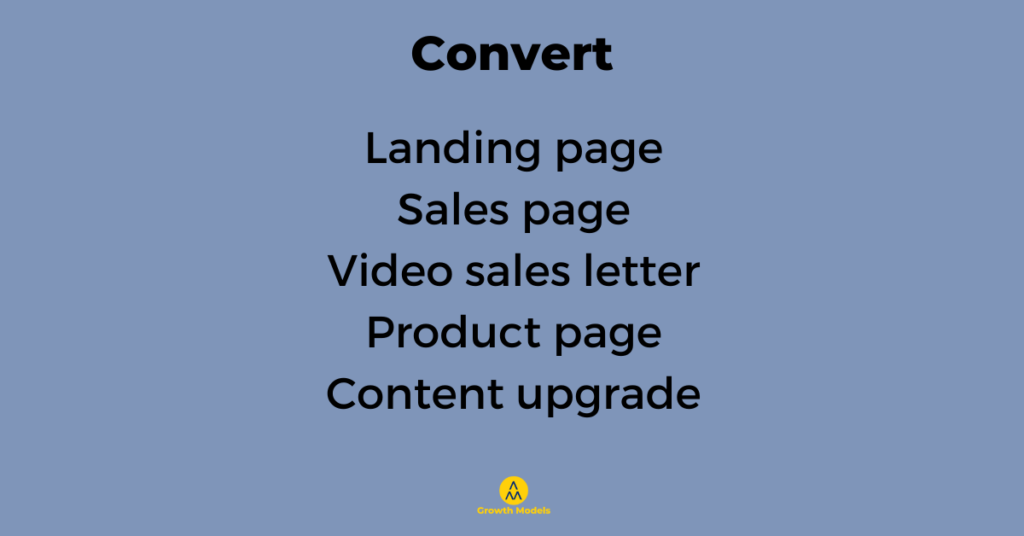
Again, it’s not like saying that “Sales pages are the best for any business”.
This is a very inaccurate view of marketing and, in my experience, identifies someone with a lack of wide experience.
The kind of conversion asset depends highly on a few elements…
- The cost of the product
- The “threat level” of the offer
- Where the users are coming from
And a whole host of other elements.
Let’s do a quick example comparison.
You’re running an information product that runs at a $2000 price point. You find you get the best sales from your email list as those people know, trust, and believe you.
Your friend has an e-commerce store that sells a product for $20. It’s a small item that sells well with anyone.
In the former, the model will likely need to be built around getting more people on the email list. So, you might find that ads to content with a simple content upgrade builds the list.
Then emails and a sales page facilitate the sale.
In the latter, a simple social ad to a product listing will get the sale.
You have to make sure that the conversion element matches the traffic source and the threat of the offer.
Bigger threats need more nurturing.
3. Engage
once someone has bought into your offer, you need to help them get maximum value from it.
Why?
Because if they don’t get the value your conversion element promises, they’re going to…
- Request a refund (money and time lost for you)
- Leave bad reviews (lowering future conversions)
A few ways you can help people engage better with your offer and get the best results.
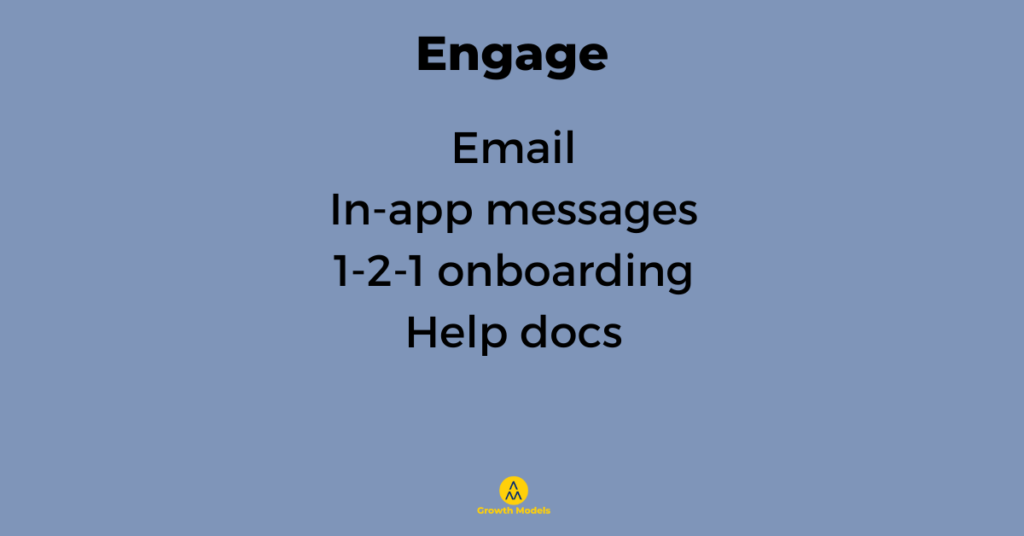
Finding the right option here really depends on two key elements.
- The complexity of the offer
- The pricing of the offer and audience
If you. have a very simple product that the ideal audience can easily get to grips with, then in-app messages through something like Intercom or email onboarding might suffice.
Think someone who’s switched from Ahrefs to SEMRush.
They know the kind of tool and it’s features they just need to get used to a new dashboard.
A more hands-off approach would be fine here.
For expensive and/or complex tools, a 1-2-1 onboarding might be better.
This is to both help set expectations and help the user get an almost immediate ROI so they don’t churn out at the first opportunity.
When someone is paying $10,000+ for a service, they want it to work ASAP. You need to help that happen for them.
4. Refer
Once someone is getting good results and loves your offer, it’s time to ask them to help with promotion.
These kind of network effects can massively speed growth. A few options include…
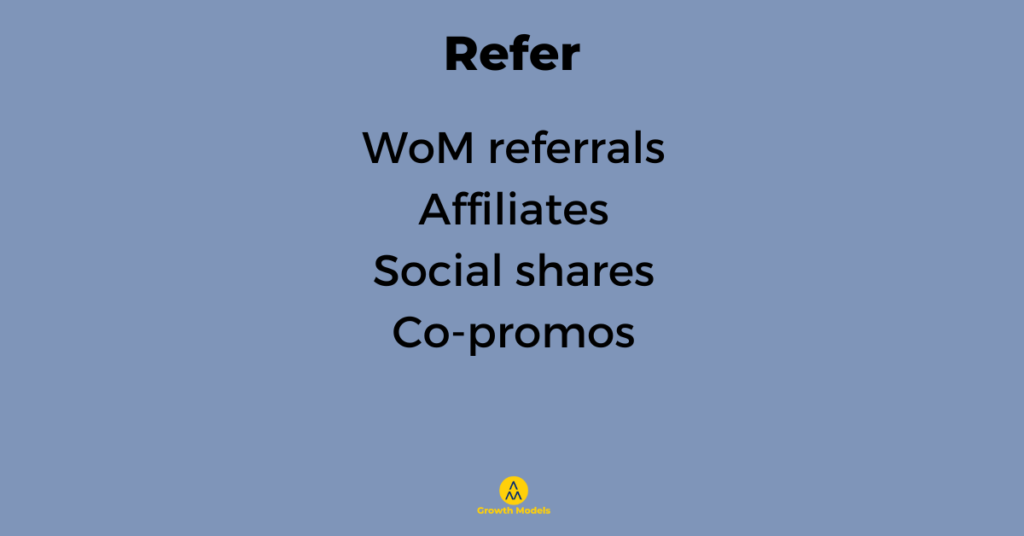
You’re usually going to need to incentivise any sort of referral approach.
And again, figuring out what’s going to work best comes down to what you can afford, and what’s a relevant “threat level” for the user.
For example, a simple social share about the great tool they’ve just used might not seem like it’s high threat.
However, if the brand is an enterprise user they might not want the details of their tech stack or sub-contractor services getting out. This is especially true for publicly traded companies who are super worried about public perception.
So choose the threat level and reward mechanism that fits with your abilities and their comfort level.
How to build a better growth model
One of the things that really bothers me within the growth marketing world is how so many people tell you “this tactic is all you need”.
- SEOs tell you SEO is the best way to grow
- Ad managers say ads are the best fro every brand
- Copywriters explain how it’s only the landing page that needs to be good
These could work, but rarely is one tactic the right choice for every brand.
And, in fact, improving only one asset within the ACER model leads to sub-par results.
For example, imagine you’re able to attract 10,000 people and have a base conversion rate of 10% at each stage.

That gives you 1000 leads, 100 who are engaged users, and 10 who are so happy they’ll promote you.
You hire a copywriter who doubles the landing page conversion to 20%.
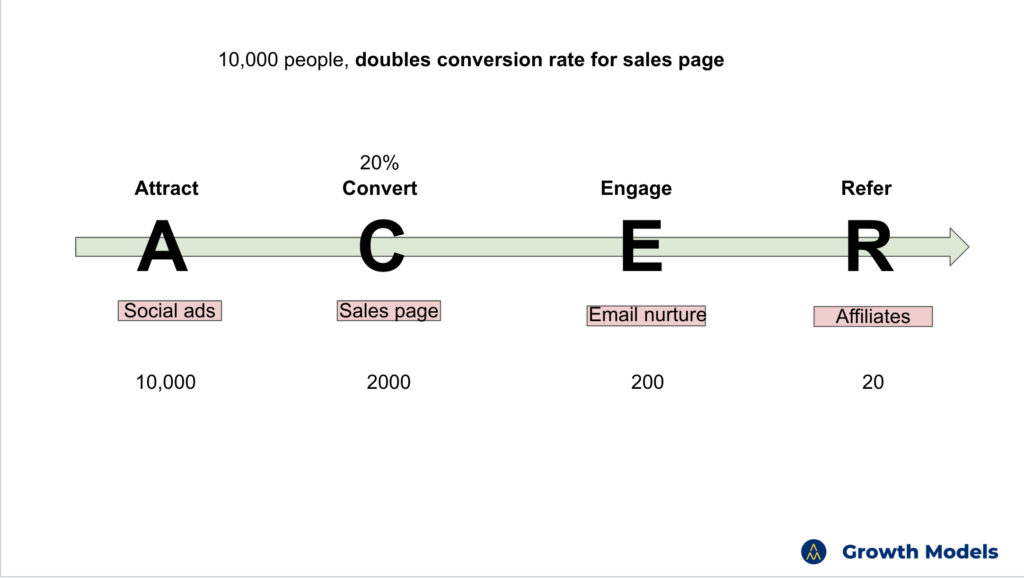
That gives you 2000 leads, 200 engaged users, 20 affiliates.
A win in anyone’s book.
But if you focused instead on making sure the right elements were delivered to the right people at the right time, you’d end up far better off.
You might not be able to double the conversions anywhere. Maybe you can only improve the conversion by 50% at each stage.
But that has a compounding effect.
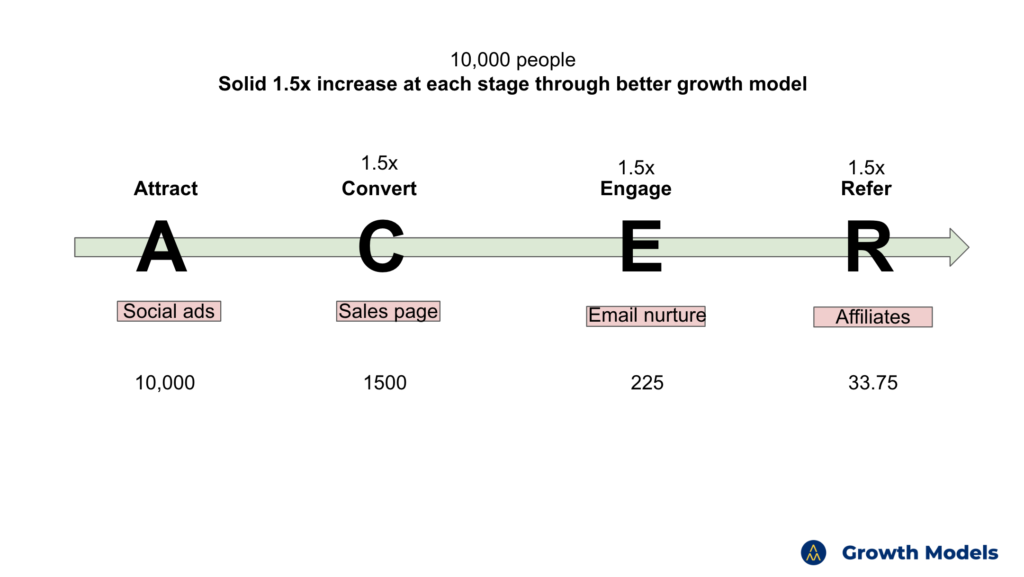
You end up in this case with only 1500 leads, but 225 users and 33 affiliates.
You’ve got fewer leads, but they’re of a higher quality and you’re getting progressively better results as you go through the ACER model.
This is what growth marketing is about.
It’s not about quick wins and improving single assets, but about building a model that improves results at every stage.
If you want to build a better system for your brand, don’t try to do too much.
Pick the best approach for each stage, the one you can get above-average results in, and link them together in a way that benefits the end user.
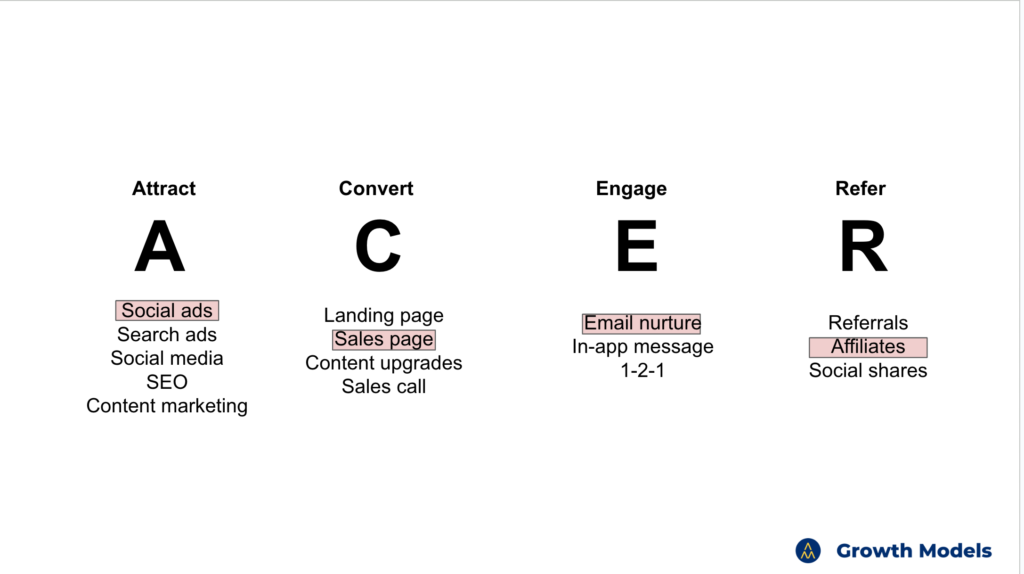
Doing this leads to more sustainable growth over the long term.
